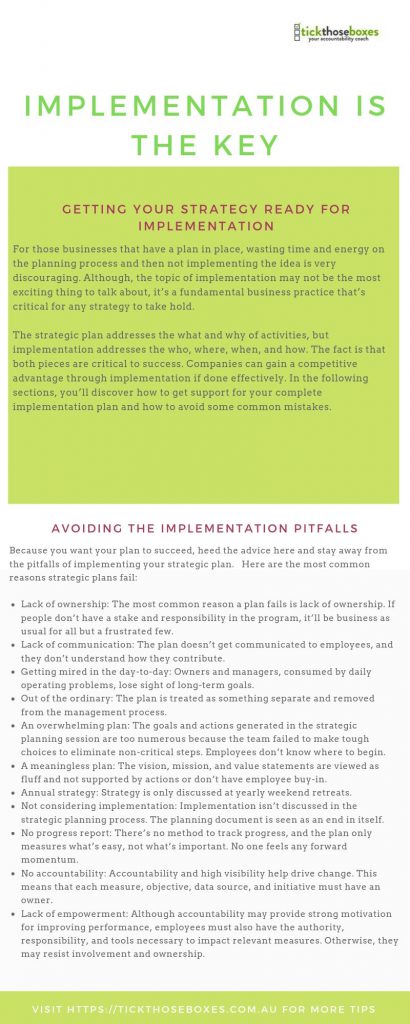
Posted on: 26/09/2019

Implementation is the process that turns strategies and plans into actions to accomplish strategic objectives and goals. Implementing your strategic plan is vital and is as essential, or even more important, than your strategy.
Critical actions move a strategic plan from a document that sits on the shelf to activities that drive business growth. Sadly, the majority of companies who have strategic plans fail to implement them.
According to Fortune Magazine, nine out of ten organizations fail to achieve their strategic plan for many reasons:
A strategic plan provides a business with the roadmap it needs to pursue a specific strategic direction and set of performance goals, deliver customer value, and be successful. However, this is just a plan; it doesn’t guarantee that the desired performance is reached any more than having a roadmap guarantees the traveller arrives at the desired destination. Interestingly, a goal without a plan, I call nothing more than a wish.
Getting Your Strategy Ready for Implementation
For those businesses that have a plan in place, wasting time and energy on the planning process and then not implementing the idea is very discouraging. Although the topic of implementation may not be the most exciting thing to talk about, it’s a fundamental business practice that’s critical for any strategy to take hold.
The strategic plan addresses the what and why of activities, but implementation addresses the who, where, when, and how. The fact is that both pieces are critical to success. Companies can gain a competitive advantage through implementation if done effectively. In the following sections, you’ll discover how to get support for your complete implementation plan and how to avoid some common mistakes.
Avoiding the Implementation Pitfalls
Because you want your plan to succeed, heed the advice here and stay away from the pitfalls of implementing your strategic plan.
Here are the most common reasons strategic plans fail:
It’s easier to avoid pitfalls when they’re identified. Now that you know what they are, you’re more likely to jump right over them!

DELIVERING WHAT YOU PROMISE
and getting your team to do the same
Do you meet the obligations, promises, goals and commitments made to yourself and to others?
The American Society of Training and Development (ASTD) did a study in 2010 on accountability and found out that the probability of completing a goal is:
After reading this, how likely are you to achieve your; goals, promises, obligations and commitments alone?
Book your FREE Unboxing Session with me ‘The Accountability Guy’ and we’ll examine exactly where you’re at, what’s worked and what hasn’t, and we’ll take a look at your priorities to set the path moving forward. Each Unboxing Session includes:
For more information visit: call me directly: +61 418-379 369.
I was excited to join Tia Harmer on The Work in Progress: The Personal Productivity Science Insights Podcast! We dive deep into the science of goal setting and the power of accountability—two cornerstones of business and personal success.